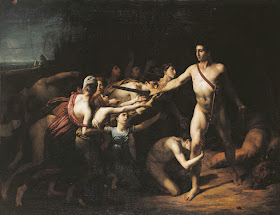 |
| Anonymous Venetian Fan-Makers Theseus at the Court of Aegeus ca. 1700-1725 gouache on paper with ivory sticks Museum of Fine Arts, Boston |
from The Metamorphoses
Now Theseus, whose father Aegeus had never known him, arrived;
his heroic deeds had established peace on the Isthmus of Corinth.
Bent on his murder, Medea prepared him a potion of aconite,
brought by her earlier over the sea from the Scythian shores.
* * *
Such was the potion Medea had craftily given to Aegeus,
Theseus' father, to offer the son whom he thought was an enemy.
Theseus, suspecting nothing, had taken the cup in his hand,
when the old king spotted the family emblem engraved on the ivory
hilt of the young man's sword and dashed the brew from his lips.
Though Theseus' father was filled with joy that his son was safe,
he was also filled with horror that such a terrible crime
had been so closely prevented.
– Ovid (8 AD), translated by David Raeburn (2004)
 |
| Benedetto Gennari Theseus with the Daughters of King Minos 1702 oil on canvas Kunsthistorisches Museum, Vienna |
 |
| Francesco de Mura Legend of Theseus 1741-43 fresco Palazzo Reale, Turin |
 |
| Jan Wandelaar Theseus and Ariadne 1749 etching Rijksmuseum, Amsterdam |
 |
| Simon Fokke Theseus at the entrance to the Labyrinth 1759 etching Rijksmuseum, Amsterdam |
 |
| Nicolas-Guy Brenet Aethra showing her son Theseus the place where his Father hid Arms 1768 oil on canvas Los Angeles County Museum of Art |
from The Metamorphoses
Here Minos confined his monster son, half man, half bull,
and fed him twice on the blood of Athenian youths and maidens,
chosen by lot as tribute exacted at nine-year intervals.
But the third repast destroyed the Minotaur. One of the youths,
Prince Theseus, was aided by fair Ariadne, the daughter of Minos.
Rewinding the thread she gave him, he found the elusive entrance
which none had regained before him.
– Ovid (8 AD), translated by David Raeburn (2004)
 |
| François Valentin after Giovanni Benedetto Castiglione Theseus recovering the Armor of Aegeus ca. 1780 drawing Minneapolis Institute of Art |
 |
| Marie-Joséphine-Angélique Mongez Theseus and Pirithoüs, clearing the earth of Brigands, deliver two Women from the hands of their Abductors 1806 drawing Minneapolis Institute of Art |
 |
| François-Joseph Heim Theseus, Vanquisher of the Minotaur 1807 oil on canvas École des Beaux-Arts, Paris |
 |
| Richard Westall Theseus and Ariadne at the entrance to the Labyrinth ca. 1810 oil on canvas North Lincolnshire Museum |
 |
| Henry Fuseli Ariadne watching the struggle of Theseus with the Minotaur ca. 1815-20 oil and gouache on paper Yale Center for British Art |
 |
| Philippus Velijn after Anne-Louis Girodet Theseus rejecting Hippolytus (illustration for Racine's Phèdre) ca. 1816 etching (working proof with white highlights) British Museum |
HIPPOLYTUS:
My father, may I ask what fatal cloud
Has troubled your majestic countenance?
Dare you not trust this secret to your son?
THESEUS:
Traitor, how dare you show yourself before me?
Monster, whom Heaven's bolts have spared too long!
Survivor of that robber crew whereof
I cleansed the earth. After your brutal lust
Scorn'd even to respect my marriage bed,
You venture – you, my hated foe – to come
Into my presence, here, where all is full
Of your foul infamy, instead of seeking
Some unknown land that never heard my name.
Fly, traitor, fly! Stay not to tempt the wrath
That I can scarce restrain, nor brave my hatred.
Disgrace enough have I incurr'd for ever
In being father of so vile a son,
Without your death staining indelibly
The glorious record of my noble deeds.
– from Phèdre (1677) by Jean Racine, translated by R. Bruce Boswell (1889)
 |
| Philippus Velijn after Mattheus Ignatius van Bree Theseus and Ariadne with the conquered Minotaur before 1836 etching Rijksmuseum, Amsterdam |
 |
| Antoni Zürcher Theseus victorious over the Minotaur (after antique sculpture) before 1837 etching Rijksmuseum, Amsterdam |
